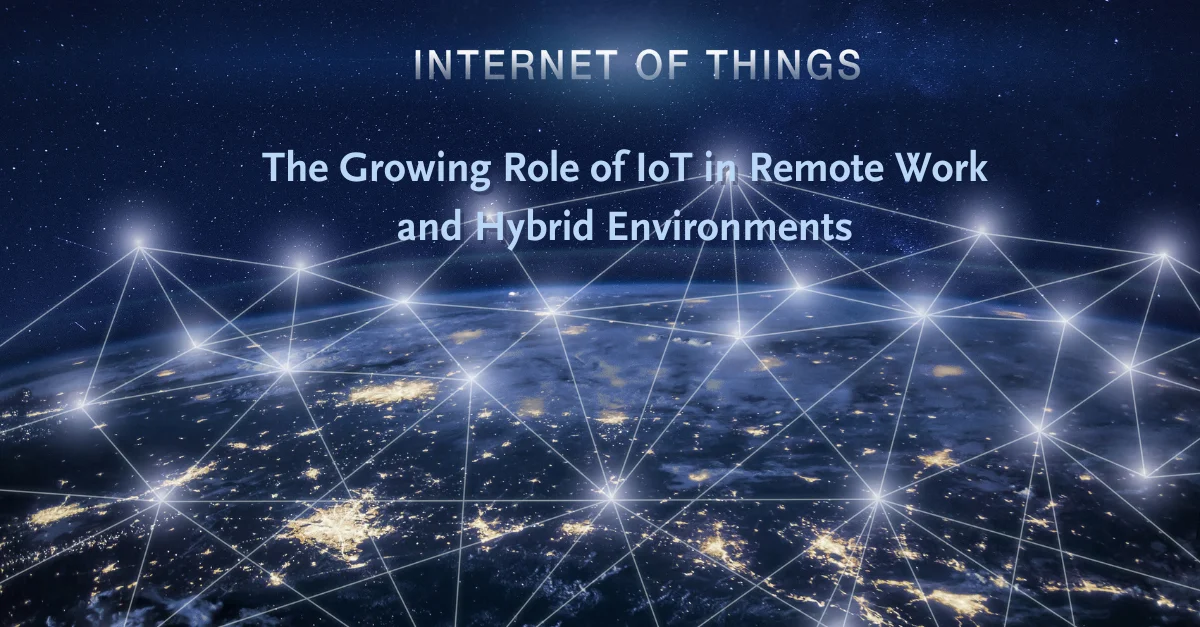The global shift towards remote and hybrid work has fundamentally transformed how we work, collaborate, and interact with technology. As organizations adapt to these new ways of working, the Internet of Things (IoT) is playing an increasingly vital role in optimizing the remote work experience, enhancing productivity, and ensuring employee well-being.
IoT in the Remote Work Revolution
IoT devices are already integrated into our everyday lives, from smartphones and smart home gadgets to wearables and connected appliances. However, their role in the workplace is expanding, particularly as businesses embrace remote and hybrid work models. With millions of employees working from home or across various locations, IoT technologies are helping bridge the gap between home and office environments.
Key Ways IoT is Enhancing Remote and Hybrid Work:
1. Improved Collaboration with Smart Meeting Rooms
- In hybrid environments, where some team members are in the office while others are remote, IoT-powered smart meeting rooms can create a seamless and collaborative experience. Devices like smart cameras, video conferencing systems, and voice-activated assistants ensure that remote participants are fully integrated into discussions. IoT sensors can automatically adjust lighting, temperature, and even screen configurations for optimal comfort and productivity.
- Intelligent scheduling systems connected to IoT devices can automatically book meeting rooms, detect occupancy, and manage space utilization, making in-person meetings more efficient and hygienic.
2. Enhanced Security and Privacy for Remote Workers
- With employees working from diverse locations, security is a critical concern. IoT devices like smart locks, security cameras, and motion sensors help protect office spaces and remote work environments. For example, IoT-enabled biometric authentication systems ensure secure access to sensitive data and devices, reducing the risk of unauthorized access.
- IoT solutions can also enable smart VPNs and real-time security monitoring, ensuring secure data transfer between remote workers and the office network.
3. Employee Well-being and Productivity Monitoring
- IoT devices can monitor employee well-being, ensuring that remote workers are physically comfortable and mentally healthy. Wearables like fitness trackers and smartwatches help employees track their health metrics, reminding them to take breaks, exercise, or hydrate during long working hours.
- IoT-enabled ergonomic furniture and smart desks can be adjusted for optimal posture and comfort, promoting healthier work environments. Sensors can monitor desk usage and suggest improvements for better workflow efficiency and employee wellness.
4. Optimizing Workspaces and Resources
- As the hybrid work model means people are often working from home or rotating through the office, IoT-powered smart offices offer flexible and efficient workspaces. IoT sensors track desk and office space utilization, ensuring that physical resources (like desks, chairs, or meeting rooms) are reserved only when needed. This reduces overcrowding and optimizes space usage.
- Smart HVAC systems, connected lighting, and automated climate control devices ensure that physical workspaces—whether at home or in the office—remain comfortable and energy-efficient. In some cases, these devices can be controlled remotely, so workers can adjust their environments from wherever they are.
5. IoT-Enhanced Communication and Workflow
- Voice assistants, like Amazon Alexa and Google Assistant, integrated into office environments, can streamline everyday tasks for employees. These IoT devices can handle scheduling, emails, reminders, and even make team communication more fluid across time zones and geographic locations.
- Smart task management platforms connected with IoT can track project progress, notify team members of updates, and help prioritize tasks. These systems automatically adjust deadlines, allocate resources, and suggest optimizations, helping hybrid teams remain aligned and productive.
6. Data-Driven Insights for Better Decision-Making
- The data generated by IoT devices can provide companies with valuable insights into employee performance, productivity trends, and resource allocation. IoT-powered systems can analyze metrics like time spent on specific tasks, frequency of breaks, and environmental factors affecting work performance, allowing managers to make data-driven decisions that enhance both individual and team performance.
- By using IoT-generated data, businesses can ensure that their hybrid models are not only effective but also continuously improving based on real-time feedback.
The Future of IoT in Remote and Hybrid Work
As the work-from-home and hybrid work models continue to evolve, IoT technology will play a crucial role in overcoming the challenges of remote collaboration, employee engagement, and productivity optimization. By enabling greater flexibility, improving workplace safety, and providing data-driven insights, IoT is empowering both businesses and employees to work smarter, not harder.
With the rise of 5G and edge computing, IoT devices will become even more powerful, allowing for faster data processing and more advanced features. These advancements will make it even easier for remote and hybrid workers to access information, stay connected, and collaborate seamlessly, regardless of their location.
Conclusion
The growth of remote and hybrid work models is reshaping the workplace, and IoT is at the forefront of this transformation. By providing enhanced collaboration tools, improving workspace efficiency, and promoting employee well-being, IoT is making remote and hybrid work more productive and sustainable than ever. As businesses continue to adapt to the evolving demands of the workforce, IoT will undoubtedly be a key enabler of success.
#IoT #RemoteWork #HybridWork #SmartWorkplace #InternetOfThings #WorkplaceInnovation #FutureOfWork #DigitalTransformation #TechForWork
